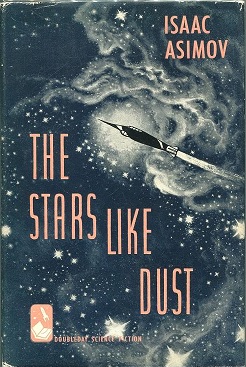The Stars, Like Dust

Dust-jacket from the first edition
|
|
| Author | Isaac Asimov |
|---|---|
| Cover artist | Whitney Bender |
| Country | United States |
| Language | English |
| Series | Empire series |
| Genre | Science fiction, Whodunit |
| Publisher | Doubleday |
|
Publication date
|
1951 |
| Media type | Print (Hardcover/Paperback) |
| Pages | 218 pp |
| Preceded by | Robots and Empire |
| Followed by | The Currents of Space |
The Stars, Like Dust is a 1951 science fiction mystery book by American writer Isaac Asimov.
The book is part of Asimov's Galactic Empire series. It takes place before the actual founding of the Galactic Empire, and even before Trantor has become important. It starts with a young man attending the University of Earth. Biron Farrill is the son of the greatest nobleman on the planet Nephelos, one of the Nebula Kingdoms. The story starts with the news that his father has been caught conspiring against the Tyranni.
The Tyranni (who come from planet Tyrann) are a minor empire that rule fifty planets near the Horsehead Nebula. Tyrann suppressed science and space navigation training in the Kingdoms, to help maintain control over its subject worlds. The ruler of Tyrann in the story is called the "Khan". Asimov obviously took the Mongol dominion over the Russian principalities as a model, much as he used the declining Roman Empire for his Foundation series. (See the "Golden Horde" for the real-world history that Asimov drew upon, and adapted.)
The story's in-universe historical context is generally regarded as quite interesting, during the long period between the initial expansion and the rise of the Empire of Trantor. But the main action in the novel revolves around one small intrigue that really resolves nothing. It is occasionally considered to be one of Asimov's somewhat lesser novels, and Asimov himself once called it his "least favorite novel."
The novel was originally serialized as Tyrann, and its first paperback edition was retitled The Rebellious Stars.
The story is set long before Pebble in the Sky, though it was written one year later. The Trantorian Empire is not directly mentioned — it would be located far away, having been settled not long beforehand, and before its first great wave of territorial expansion. Earth's radioactivity is explained here as the result of an unspecified nuclear war. This contradicts what Asimov later wrote in Robots and Empire. One could suppose that history has become muddled over the intervening centuries since the final Robot novel — "many of the inhabitants of the planets near the Horsehead Nebula now believe it was named after an explorer called Horace Hedd." Other theories exist. And when Biron pretends on Rhodia that he comes from Earth, the Earth is not recognized, and he has to identify it as "a small planet of the Sirian Sector".
...
Wikipedia
